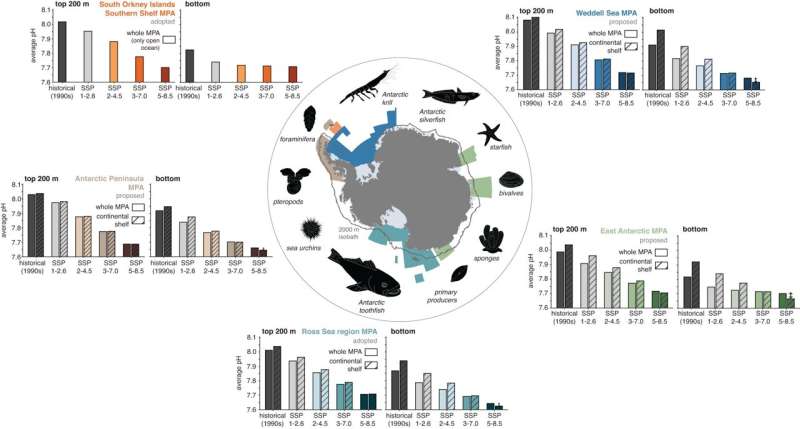This article has been reviewed according to Science X's editorial process and policies. Editors have highlighted the following attributes while ensuring the content's credibility:
fact-checked
peer-reviewed publication
trusted source
proofread
Acidity of Antarctic waters could double by century's end, threatening biodiversity, say scientists

The acidity of Antarctica's coastal waters could double by the end of the century, threatening whales, penguins and hundreds of other species that inhabit the Southern Ocean, according to new research from the Univeristy of Colorado Boulder.
Scientists projected that by 2100, the upper 650 feet (200 meters) of the ocean—where much marine life resides—could see more than a 100% increase in acidity compared with 1990s levels. The paper, appeared Jan. 4 in the journal Nature Communications.
"The findings are critical for our understanding of the future evolution of marine ecosystem health," said Nicole Lovenduski, the paper's co-author and the interim director of CU Boulder's Institute of Arctic and Alpine Research (INSTAAR).
The oceans play an important role as a buffer against climate change by absorbing nearly 30% of the CO2 emitted worldwide. But as more CO2 dissolves in the oceans, the seawater becomes more acidic. "Human-caused CO2 emissions are at the heart of ocean acidification," said Cara Nissen, the paper's first author and a research scientist at INSTAAR.
The Southern Ocean, which surrounds Antarctica, is particularly susceptible to acidification, partly because colder water tends to absorb more CO2. Ocean currents in the area also contribute to the relatively acidic water conditions.
Using a computer model, Nissen, Lovenduski and the team simulated how the seawater of the Southern Ocean would change in the 21st century. They found it would become more acidic by 2100, and the situation would be severe if the world fails to cut emissions.
"It's not just the top layer of the ocean. The entire water column of the coastal Southern Ocean, even at the bottom, could experience severe acidification," Nissen said.
The team then investigated the conditions specifically in Antarctica's marine protected areas (MPAs). Human activities, such as fishing, are restricted in these regions to protect biodiversity. Currently, there are two MPAs in the Southern Ocean, covering about 12% of water in the region. Scientists have proposed designating three more MPAs to an international council in the past years, which would encompass about 60% of the Antarctic Ocean.
The team's model showed that both adopted and proposed MPAs would experience significant acidification by the end of the century.
For example, under the highest-emission scenario, where the world makes no efforts to cut emissions, the average acidity of the water in the Ross Sea region—the world's largest MPA off the northern tip of Antarctica—would increase by 104% over 1990s levels by 2100. Under an intermediate emissions scenario, the water would still become 43% more acidic.
"It's surprising to me how severe ocean acidification would be in these coastal waters," Nissen said.
Previous studies have shown that phytoplankton, a group of algae that forms the basis of the marine food web, grow at a slower rate or die out when the water becomes too acidic. Acidic water also weakens the shells of organisms like sea snails and sea urchins. These changes could disrupt the food web, eventually impacting top predators like whales and penguins.
The Weddell Sea is one of the three proposed MPAs located off the coast of the Antarctic Peninsula. Nissen said scientists think the Weddell Sea region could act as a climate change sanctuary for organisms, mainly because this area has the highest levels of sea ice coverage in the Antarctic. The ice shields the ocean from warming and prevents the seawater underneath from absorbing CO2 from the air, thereby reducing the rate of acidification. In addition, the region has little human activity to date.
But the model suggested that as the planet continues to warm, the sea ice will melt, and the Weddell Sea region will experience acidification on par with other MPAs under intermediate to high emission scenarios, but with a slightly delayed progression.
"The result shows that establishing the Weddell Sea region as a protected area should have high priority," Nissen said.
"As a scientist who typically studies the open ocean, I tend to think of Antarctic coastal areas as a conduit for climate signals to reach the global, deep ocean. This study reminded me that these dynamic Antarctic coastal areas are also themselves capable of rapid change," Lovenduski said.
The study suggests that the world could only avoid severe ocean acidification of the Southern Ocean under the lowest emission scenario, where society cuts CO2 emissions quickly and aggressively.
"We still have time to select our emission pathway, but we don't have much," Nissen said.
More information: Cara Nissen et al, Severe 21st-century ocean acidification in Antarctic Marine Protected Areas, Nature Communications (2024). DOI: 10.1038/s41467-023-44438-x
Journal information: Nature Communications
Provided by University of Colorado at Boulder




















